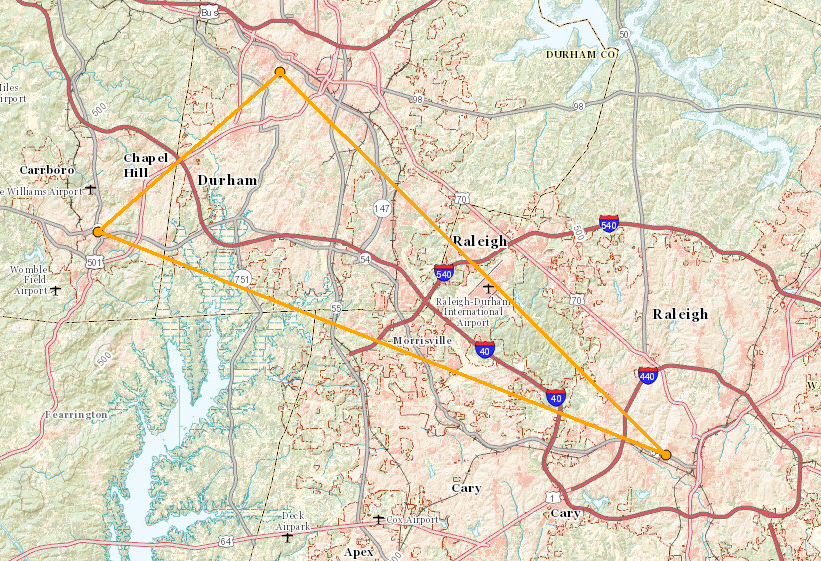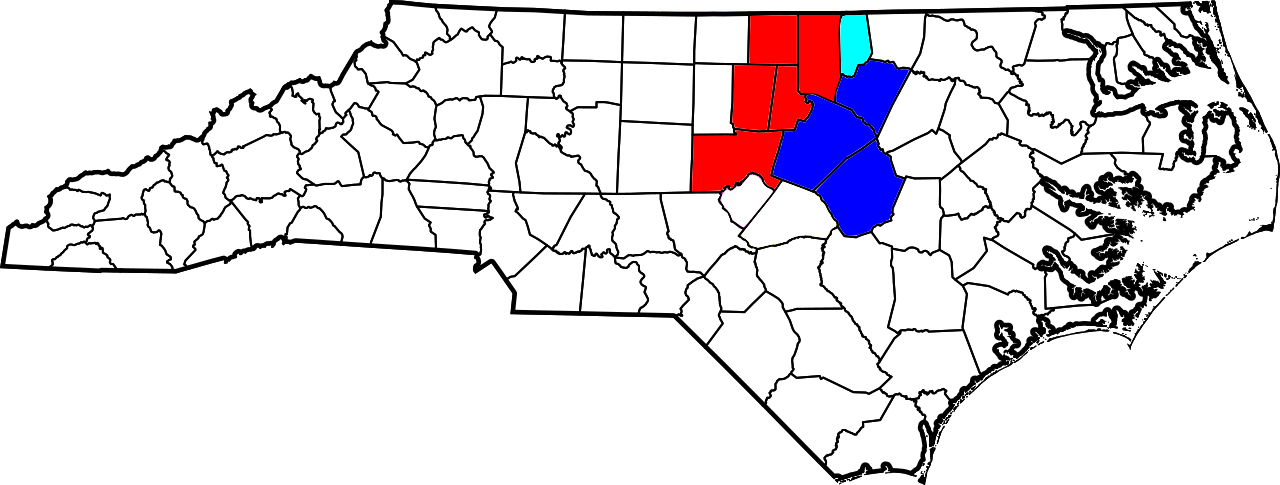|
WKNC
WKNC-FM (88.1 FM) is North Carolina State University's student-run, non-commercial college radio station broadcasting from Raleigh, North Carolina in the United States. Broadcasting with an effective radiated power of 25,000 watts, its signal covers much of the Research Triangle and outlying areas. The station is operated as part of the Department of Student Media at N.C. State and students hold all roles from DJ to general manager. The primary weekday format is indie rock, with specialty shows and other music genres featured during the evenings and weekends. Programming WKNC HD-1 and HD-2 are classified as a variety radio station by Nielsen Audio, providing block programming divided into four main formats: Daytime Rock (primarily indie rock), Afterhours (electronic), Underground ( hip-hop), and Chainsaw Rock ( heavy metal). The "Local Lunch" airs weekdays from 12 to 1 p.m. on HD-1 and from 1 to 2 p.m., during which only North Carolina artists are played. Like many non-commer ... [...More Info...] [...Related Items...] OR: [Wikipedia] [Google] [Baidu] |
North Carolina State University
North Carolina State University (NC State) is a public land-grant research university in Raleigh, North Carolina. Founded in 1887 and part of the University of North Carolina system, it is the largest university in the Carolinas. The university forms one of the corners of the Research Triangle together with Duke University in Durham and the University of North Carolina at Chapel Hill. It is classified among "R1: Doctoral Universities – Very high research activity". The North Carolina General Assembly established the North Carolina College of Agriculture and Mechanic Arts, now NC State, on March 7, 1887, originally as a land-grant college. The college underwent several name changes and officially became North Carolina State University at Raleigh in 1965. However, by longstanding convention, the "at Raleigh" portion is usually omitted. Today, NC State has an enrollment of more than 35,000 students, making it among the largest in the country. NC State has historical strengths ... [...More Info...] [...Related Items...] OR: [Wikipedia] [Google] [Baidu] |
Research Triangle
The Research Triangle, or simply The Triangle, are both common nicknames for a metropolitan area in the Piedmont region of North Carolina in the United States, anchored by the cities of Raleigh and Durham and the town of Chapel Hill, home to three major research universities: North Carolina State University, Duke University, and University of North Carolina at Chapel Hill, respectively. The nine-county region, officially named the Raleigh–Durham–Cary combined statistical area (CSA), comprises the Raleigh–Cary and Durham–Chapel Hill Metropolitan Statistical Areas and the Henderson Micropolitan Statistical Area. The "Triangle" name originated in the 1950s with the creation of Research Triangle Park, located between the three anchor cities and home to numerous high tech companies. A 2019 Census estimate put the population at 2,079,687, making it the second largest combined statistical area in the state of North Carolina behind Charlotte CSA. The Raleigh–Durham t ... [...More Info...] [...Related Items...] OR: [Wikipedia] [Google] [Baidu] |
Raleigh, North Carolina
Raleigh (; ) is the capital city of the state of North Carolina and the List of North Carolina county seats, seat of Wake County, North Carolina, Wake County in the United States. It is the List of municipalities in North Carolina, second-most populous city in North Carolina, after Charlotte, North Carolina, Charlotte. Raleigh is the tenth-most populous city in the Southeastern United States, Southeast, List of United States cities by population, the 41st-most populous city in the U.S., and the largest city of the Research Triangle metro area. Raleigh is known as the "City of Oaks" for its many oak, oak trees, which line the streets in the heart of the city. The city covers a land area of . The United States Census Bureau, U.S. Census Bureau counted the city's population as 474,069 in the 2020 United States census, 2020 census. It is one of the fastest-growing cities in the United States. The city of Raleigh is named after Sir Walter Raleigh, who established the lost Roanoke Co ... [...More Info...] [...Related Items...] OR: [Wikipedia] [Google] [Baidu] |
Raleigh-Durham, North Carolina
The Research Triangle, or simply The Triangle, are both common nicknames for a metropolitan area in the Piedmont region of North Carolina in the United States, anchored by the cities of Raleigh and Durham and the town of Chapel Hill, home to three major research universities: North Carolina State University, Duke University, and University of North Carolina at Chapel Hill, respectively. The nine-county region, officially named the Raleigh–Durham–Cary combined statistical area (CSA), comprises the Raleigh–Cary and Durham–Chapel Hill Metropolitan Statistical Areas and the Henderson Micropolitan Statistical Area. The "Triangle" name originated in the 1950s with the creation of Research Triangle Park, located between the three anchor cities and home to numerous high tech companies. A 2019 Census estimate put the population at 2,079,687, making it the second largest combined statistical area in the state of North Carolina behind Charlotte CSA. The Raleigh–Durham te ... [...More Info...] [...Related Items...] OR: [Wikipedia] [Google] [Baidu] |
Jazz
Jazz is a music genre that originated in the African-American communities of New Orleans, Louisiana in the late 19th and early 20th centuries, with its roots in blues and ragtime. Since the 1920s Jazz Age, it has been recognized as a major form of musical expression in traditional and popular music. Jazz is characterized by swing and blue notes, complex chords, call and response vocals, polyrhythms and improvisation. Jazz has roots in European harmony and African rhythmic rituals. As jazz spread around the world, it drew on national, regional, and local musical cultures, which gave rise to different styles. New Orleans jazz began in the early 1910s, combining earlier brass band marches, French quadrilles, biguine, ragtime and blues with collective polyphonic improvisation. But jazz did not begin as a single musical tradition in New Orleans or elsewhere. In the 1930s, arranged dance-oriented swing big bands, Kansas City jazz (a hard-swinging, bluesy, improvisationa ... [...More Info...] [...Related Items...] OR: [Wikipedia] [Google] [Baidu] |
Psychedelic Music
Psychedelic music (sometimes called psychedelia) is a wide range of popular music styles and genres influenced by 1960s psychedelia, a subculture of people who used psychedelic drugs such as LSD, psilocybin mushrooms, mescaline, and cannabis to experience synesthesia and altered states of consciousness. Psychedelic music may also aim to enhance the experience of using these drugs and has been found to have a significant influence on psychedelic therapy. Psychedelia embraces visual art, movies, and literature, as well as music. Psychedelic music emerged during the 1960s among folk and rock bands in the United States and the United Kingdom, creating the subgenres of psychedelic folk, psychedelic rock, acid rock, and psychedelic pop before declining in the early 1970s. Numerous spiritual successors followed in the ensuing decades, including progressive rock, krautrock, and heavy metal. Since the 1970s, revivals have included psychedelic funk, neo-psychedelia, and stoner rock as ... [...More Info...] [...Related Items...] OR: [Wikipedia] [Google] [Baidu] |
Post-rock
Post-rock is a form of experimental rock characterized by a focus on exploring textures and timbre over traditional rock song structures, chords, or riffs. Post-rock artists are often instrumental, typically combining rock instrumentation with electronics. The genre emerged within the indie and underground music scene of the 1980s and early 1990s. However, due to its abandonment of rock conventions, it often bears little resemblance musically to contemporary indie rock, borrowing instead from diverse sources including ambient, electronica, jazz, krautrock, dub, and minimalist classical. Artists such as Talk Talk and Slint have been credited with producing foundational works in the style in the early 1990s. The term post-rock itself was notably employed by journalist Simon Reynolds in a review of the 1994 Bark Psychosis album '' Hex''. It later solidified into a recognizable trend with the release of Tortoise's 1996 album ''Millions Now Living Will Never Die''. The term has ... [...More Info...] [...Related Items...] OR: [Wikipedia] [Google] [Baidu] |
A Cappella
''A cappella'' (, also , ; ) music is a performance by a singer or a singing group without instrumental accompaniment, or a piece intended to be performed in this way. The term ''a cappella'' was originally intended to differentiate between Renaissance polyphony and Baroque concertato musical styles. In the 19th century, a renewed interest in Renaissance polyphony, coupled with an ignorance of the fact that vocal parts were often doubled by instrumentalists, led to the term coming to mean unaccompanied vocal music. The term is also used, rarely, as a synonym for ''alla breve''. Early history A cappella could be as old as humanity itself. Research suggests that singing and vocables may have been what early humans used to communicate before the invention of language. The earliest piece of sheet music is thought to have originated from times as early as 2000 B.C. while the earliest that has survived in its entirety is from the first century A.D.: a piece from Greece called the ... [...More Info...] [...Related Items...] OR: [Wikipedia] [Google] [Baidu] |
Soul Music
Soul music is a popular music genre that originated in the African American community throughout the United States in the late 1950s and early 1960s. It has its roots in African-American gospel music and rhythm and blues. Soul music became popular for dancing and listening, where U.S. record labels such as Motown, Atlantic and Stax were influential during the Civil Rights Movement. Soul also became popular around the world, directly influencing rock music and the music of Africa. It also had a resurgence with artists like Erykah Badu under the genre neo-soul. Catchy rhythms, stressed by handclaps and extemporaneous body moves, are an important feature of soul music. Other characteristics are a call and response between the lead vocalist and the chorus and an especially tense vocal sound. The style also occasionally uses improvisational additions, twirls, and auxiliary sounds. Soul music reflects the African-American identity, and it stresses the importance of an African-Ameri ... [...More Info...] [...Related Items...] OR: [Wikipedia] [Google] [Baidu] |
Western Swing
Western swing music is a subgenre of American country music that originated in the late 1920s in the Western United States, West and Southern United States, South among the region's Western music (North America), Western string bands. It is dance music, often with an up-tempo beat, which attracted huge crowds to dance halls and clubs in Texas, Oklahoma and California during the 1930s and 1940s until a federal war-time nightclub tax in 1944 contributed to the genre's decline.''Stomping the Blues''. Albert Murray. Da Capo Press. 2000. page 109, 110. , The movement was an outgrowth of jazz. The music is an amalgamation of American roots music, rural, Western music (North America), cowboy, polka, Old-time music, old-time, Dixieland jazz, and blues blended with swing music, swing; and played by a Musical improvisation, hot string band often augmented with drums, saxophones, pianos and, notably, the steel guitar. The electrically amplified stringed instruments, especially the steel g ... [...More Info...] [...Related Items...] OR: [Wikipedia] [Google] [Baidu] |







